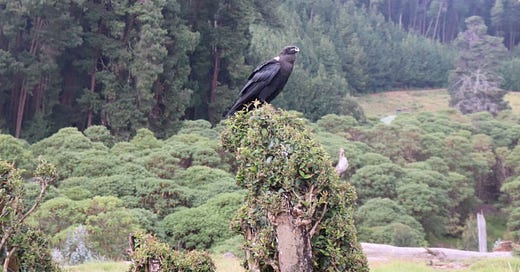WAR ON INVASIVE ALIEN SPECIES
Taking the fight against spread of invasive alien species to protected areas and surrounding villages; preventing new invasions and reduce severe impacts on ecosystems in Malawi.
Pinus Patula also known as Pine trees introduced in Nyika National Park for fuelwood and as windshield British colonial masters in 1950’s are now shading out native plant species and outcompeting native plant and animal species for light, food, water and space. (Photo: Climate Africa Digest.
RUMPHI (Malawi) Invasive species, whether native or alien, are a menace to the environment. The invasive alien species are plants or animals that have been transported outside their natural home range and introduced to new locations either intentionally or accidentally. These species are usually able to reproduce and spread quickly, often outcompeting native plant and animal species for food water and space.
Actually, invasive plants are capable of completely displacing native plants such that even wildlife populations that were previously thriving on the native plants will begin to decline.
Zebras enjoying their natural habitat in Nyika National Park (Photo: Climate Africa Digest)
According to the World Conservation Union, invasive alien species are the second most significant threat to biodiversity, after habitat loss.
As efforts to deal with invasive alien species in Malawi, the Environmental Affairs Department has for the past six years been spearheading a project aimed at enhancing the Southern African country’s capacity to manage invasive alien species in protected areas and surrounding Agro- ecosystems by strengthening existing national and protected area frameworks for the prevention and management of invasive alien species.
The project is known as Enhancing Sustainability of Protected Area Systems in Malawi and Stabilizing Agro-ecosystems in Adjoining Areas through Improved Alien Invasive Species Management Project or in short, the Invasive Alien Species Management Project. It started in March 2018 and was supposed to be completed by December 2023 but was extended to May 2024 due to COVID 19 disruptions.
Piloted in Nyika National Park in the northern region and Mulanje Mountain Forest Reserve in the southern region, the Invasive Alien Species Management Project sought to establish a national framework and capacity to enhance invasive alien species management in protected areas and associated Agro-ecosystems; strengthen on the ground invasive alien species management in existing protected areas through invasive control and habitat restoration as well as in the adjoining Agro-ecosystems through sustainable farming and improved welfare and to improve knowledge management and broader adoption of developed strategies in the country’s protected areas.
Environmental Affairs Department in the Ministry of Natural Resources and Climate Change is the project executing agency while the United Nations Environment Programme (UNEP) is its implementing agency. Other supporting agencies are Centre for Agriculture and Biosciences International (CABI) which provides technical support; Department of Forestry, National Parks and Wildlife, Museums and Monuments, Department of Agriculture Research Services (DARS) the National Herbarium and Botanical Gardens, Forest Research Institute of Malawi (FRIM) the Malawi College of Forestry and Wildlife, Peace Parks Foundation, Mulanje mountain Conservation Trust, Lilongwe Wildlife Trust, Total Land Care, Churches Action in Relief Development (CARD) Blantyre Water Board and Wildlife Environment Society of Malawi (WESM) among others who are providing technical and co-financing support.
Principally, the project has manage to establish frameworks like the National Invasive Species Strategy and Action Plan (NISSAP), Early Detection and Rapid Response Procedures and a communication strategy which are important for national implementation of invasive species interventions. The Malawi Environment Protection Authority (MEPA) has also included invasive alien species as part of its mandate and has included NISSAP actions in its newly launched five-year strategic plan.
The project has significantly strengthened the integration of invasive alien species aspects in the management operations like clearing of pine trees and other invasive species such as Black Wattle and Bracken Fern in Nyika National Park and Mulanje Mountain Forest Reserve.
Essentially, the project has supported clearing of 455.58 hectares of invasive alien species in Mulanje Mountain and over 100 hectares of invasive species in Nyika National Park. Peace Park Foundation and Wells of Zoe have co-financed the clearing of invasives in Nyika National Park while Blantyre Water Board has supported the restoration of indigenous trees in Mulanje mountain. In terms of adjoining Agro-ecosystems, the project has enhanced supported sustainable farming practices and management of invasive species in buffer zones adjoining the protected areas in 100 hectare farmlands.
Clearing invasive species in Nyika National Park is creating space for wildlife populations to thrive (Photo: Climate Africa Digest).
Additionally, there have been awareness programmes on radio, TV and Newspapers including media trainings led by Lilongwe Wildlife Trust and WESM in collaboration with extension officers to enhance knowledge and actions on invasive alien species at national and local levels.
Work has also been implemented on managing invasive species in Agro-ecosystems adjoining Nyika National Park and Mulanje Mountain Forest Reserve which is being led by Total Land Care and CARD in collaboration with local government units, non governmental organisations and other local experts who work hand in hand with protected area authorities on shared invasive alien species concerns.
While the Malawi College of Forestry and Wildlife, the collage that is mandated to train protected area staff has also introduced a course on invasive species through the support of the project which will enhance the mainstreaming of invasive alien species in protected area activities and have already trained close to 100 protected area personnel on invasive species management.
The project support had already led to a significant increase in management effectiveness as measured by the METT score card. As one of the few GEF project countries, the project has succeeded to obtain government permission to bio-control agents to control the spread of number of invasive alien species.
Left unchecked Bracken Fern invasion could result in loss of diverse plant species on which wildlife populations in protected areas depend for survival.
Bracken Fern out growing cassava and sweet potato crops at Ntchenachena, an area adjoining the Nyika National Park in Rumphi (Pics: Climate Africa Digest)








